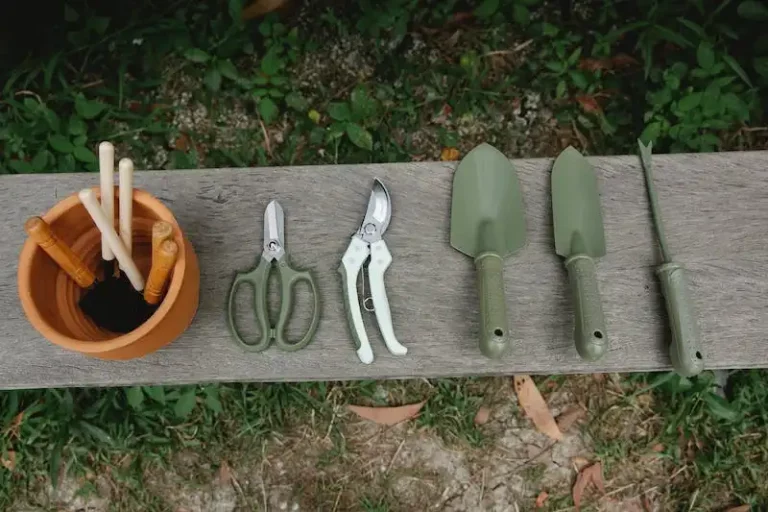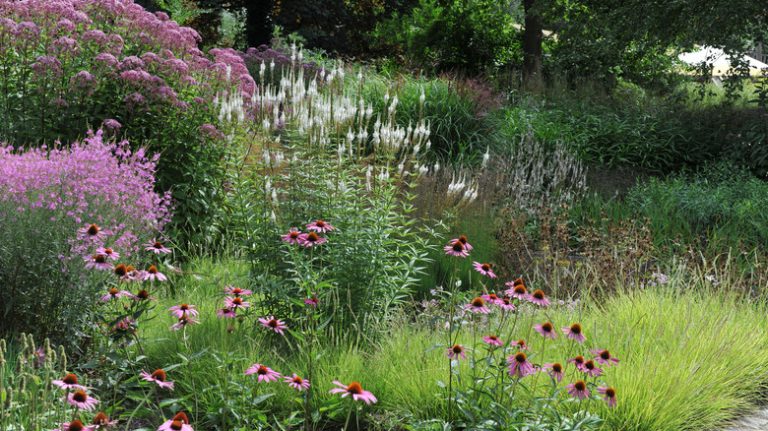Winter doesn’t have to mark the death of blooming plants in your yard. While a cold season landscape can be striking on its own with sparkling snow and bare tree branches, adding some winter-blooming flowers goes a long way to give your yard some much-needed color during this otherwise dull period. No matter which region you live in, there are a few options to choose from; the Napa Master Gardener Column (NMGC) from University of California suggests well-known winter bloomers such as cyclamen, pansies, and manzanita, all of which are gorgeous during the chilly months. However, there are others that will fare even better during the harsh winters of the northern regions.
Deciding on your best options for a winter garden will depend on your USDA growing zone. Some plants can bloom even when the weather hits single digits such as witch hazel trees (via NMGC). To find out what will work best in your area, make sure that you know each plant’s hardiness zone to avoid killing those that can’t handle freezing temperatures. In this collection, we’ve compiled five brightly colored flowering plants that bloom during the coldest months of the year in several different areas. Even if you live in the northernmost region of the United States, you can still grow blooming plants!
Japanese camellia
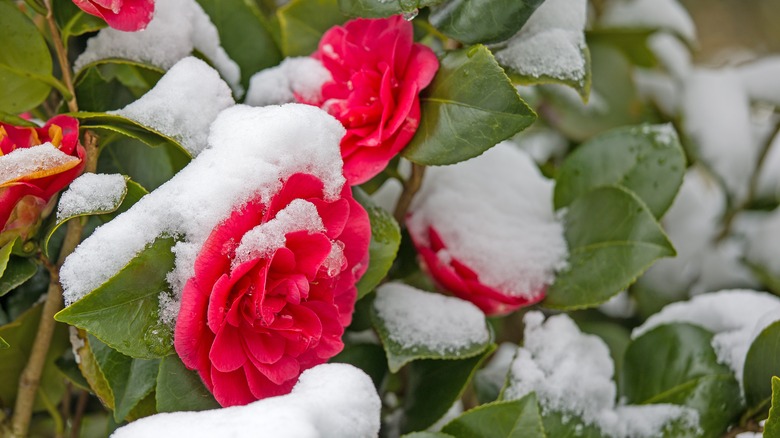
Japanese camellia (Camellia japonica), a broadleaf evergreen shrub hardy to USDA zone seven, shows off red, pink, rose, and white colored flowers from early winter to spring, per Oregon State University (OSU). The bush features dense branching stems that are littered with green leaves and many flower buds just before blooming. Thankfully, the perennial plant rises high above the ground. This means that its flowers bloom above the snow for a bold display of color while most other plants stay bare.
The camellia bush can grow as tall as 15 feet high when cared for properly, says OSU. Be sure to plant it in an area that receives some shade and some sun. Growing it near a building on the east-facing side will make sure that your shrub gets plenty of sunlight in the morning as well as protection from harsh wind throughout the year. Japanese camellias prefer well-draining, evenly moist, and organic soil. If your landscape features average garden soil you can amend it with compost or other soil conditioners to provide your plant with more nutrients.
Nutrient-dense soil will assist in the plant’s large growth habit, which makes it perfect for use as a backdrop in a border garden. Planting the bush against a fence among other plants can also be very beneficial for support. Also, if you aren’t a fan of its dense pyramidal growth, it can be pruned into a round, rectangular, or hedge-like shape.
Ornamental kale
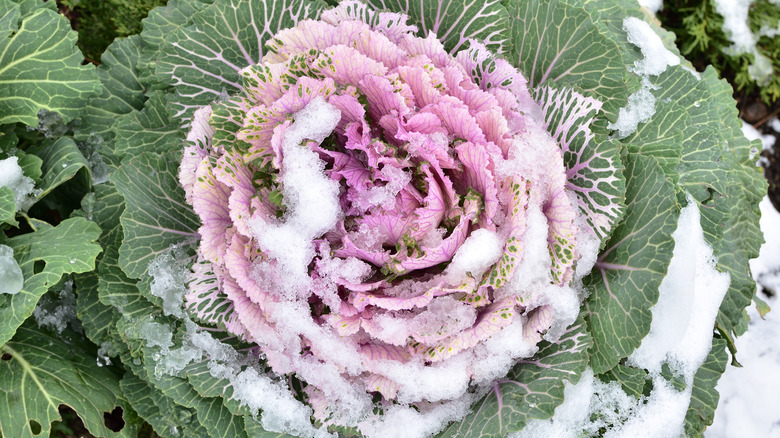
Ornamental kale plants (Brassica oleracea var. acephala) are usually grown for their leafy, visual interest in the garden among other cool-weather plants. This healthy vegetable in the Brassicaceae family has thick and waxy leaves that can appear in an array of colors including purple, pink, green, red, and white, explains North Carolina State Extension. Other common names for ornamental kale are decorative and flowering kale; that’s because this leafy green vegetable forms colorful rosettes at its center that resemble large flowers during all four seasons. Real flowers rarely appear on ornamental kale, and they should never bloom during the winter.
Typically, flowering kale plants grow to 14 inches tall and 18 inches wide. With plenty of direct sunlight and rich, well-draining soil, the plant will survive until it is overwhelmed by the heat of the summer. Before then, gardeners have the option to harvest the kale for eating, which is packed with good vitamins and nutrients such as vitamin C. Keep in mind, however, some ornamental cultivars are not considered edible due to their bitter taste.
Christmas rose
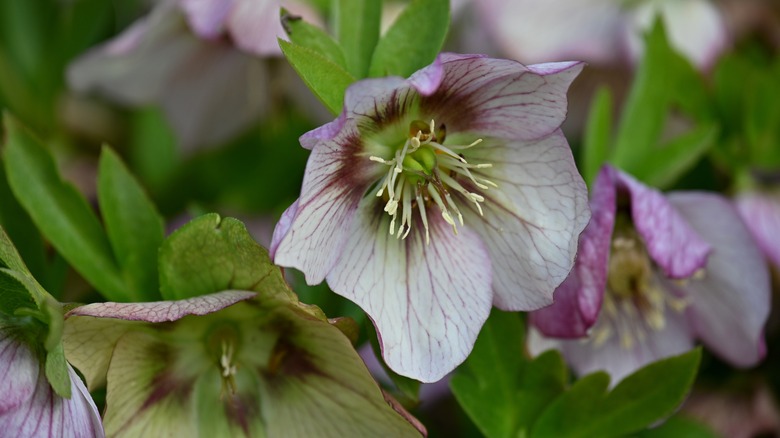
Violeta Beigiene/Shutterstock
Christmas roses or lenten roses (Helleborus × hybridus ‘Harvington Red’) are actually not roses at all. They are a species of long-blooming hellebores that can be identified by their dark green, waxy leaves, and deep pinkish red blooms. According to the Royal Horticultural Society, the flowers of the lenten rose plant can last for up to three months, and they tend to appear long before any other plant starts to bloom in the spring. Typically, this hellebore species will produce flowers in mid to late winter. Depending on where you live, Christmas roses will open from late December to early March.
To make sure that your lenten roses bloom profusely, you must plant the flowers in a somewhat shady area that receives less than six hours of direct sunlight per day. This location should also have fertile and well-draining soil with a high content of rich organic matter. When your Christmas rose plant has all of this and plenty of water, it will grow more than 1.5 feet high and wide.
Crocus
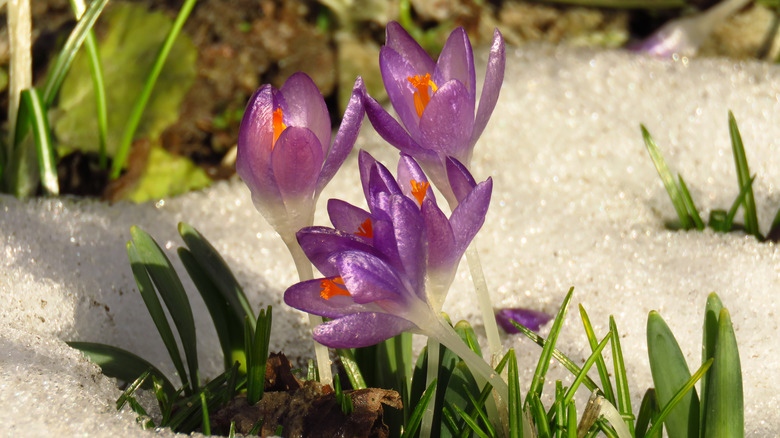
Przemyslaw Muszynski/Shutterstock
Crocus flowers (Crocus vernus) are known for their delicate blooms that pop up through the snow in the winter. These early season flowers stay open for up to three weeks, per Missouri Botanical Garden, but they are extremely fragile. Simply touching one of the petals of this European flower can force the bloom to die for the rest of the season. During the crocus’s flowering period, its blossoms have a habit of staying open during the day and closing as night approaches. Rainy and cloudy days can also convince the flowers to stay shut. Still, this low-maintenance plant is worth growing in a winter garden that needs more color because its iris-like blossoms bring vibrant shades of purple where it’s most needed.
If you love crocus flowers, consider planting yours in a mass planting in the yard, or in sections along pathways or under trees. The winter-flowering plant can grow in full sun or partial shade as long as the soil beneath it drains well. Keep in mind that once your crocus plant is established it will go dormant at the end of spring after flowering. However, because the plant is grown from corms, it will reappear each year and grow more corms that will need to be divided every five years or so.
Winter heath
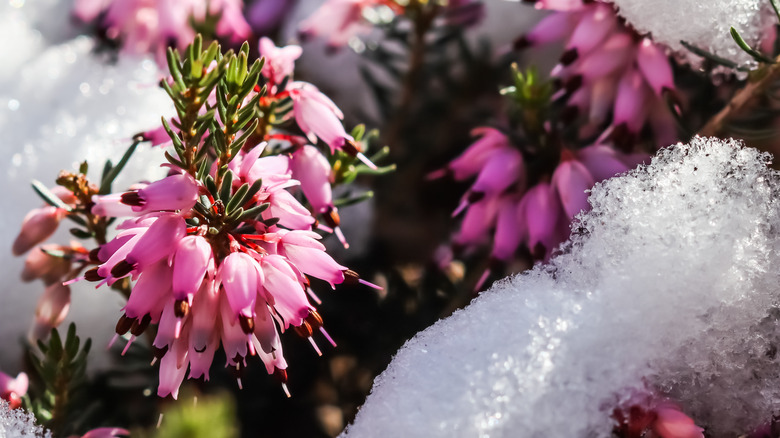
OLAYOLA/Shutterstock
Winter heath (Erica carnea) is a low-growing ground cover plant that produces clusters of pink flowers among needle-like leaves on thin branches. Most often, the small shrub will not grow higher than 9 inches tall, but it has a mat-forming growth habit that will cause it to spread up to 2 feet wide. If you want to grow winter heath as a ground cover, you can grow several plants right next to each other to create a carpet of pink winter-blooming flowers with little effort. North Carolina State Extension suggests using winter heath when designing a rock garden, winter garden, or mass planting. Their master gardeners also mention that the plant grows well on slopes that could use some texture and color.
When growing winter heath, the most important thing to remember is that it needs well-draining soil. Access to too much water can quickly lead to major, life-threatening problems such as root rot. You should also look for powdery mildew, rust, and wilt, which are known to affect this plant. As a cold-weather plant, this broadleaf evergreen is intolerant of hot and dry climates. It prefers the cooler temperatures in the summer provided by northern regions. With good sunlight and nutrient-rich soil, your winter heath plant should produce a gorgeous display of delicate bell-shaped flowers in the winter that last until the end of spring.


